About Webb
THE TELESCOPE
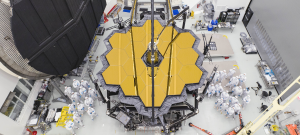
The James Webb Space Telescope sits in front of the door to Chamber A, a giant thermal vacuum chamber located at NASA’s Johnson Space Center. Credit: NASA/Chris Gunn.
The James Webb Space Telescope (JWST) is the most powerful space telescope ever built. Its four instruments, one of which was developed by Canada, will enable breakthrough discoveries in a number of fields of astronomy.
Launch date: December 25 2021
Estimated mission lifetime: 10+ years
Status: Commissioning underway
Webb has been in development since the late 1990s and was launched on December 25, 2021 from the Guiana Space Centre in Kourou, French Guiana on an Ariane 5 rocket.
JWST Deployment Sequence
The James Webb Space Telescope is the world’s next-generation space observatory and successor to the Hubble Space Telescope. The most powerful space telescope ever built, the Webb Telescope will observe the most distant objects in the universe, provide images of the first galaxies formed and see unexplored planets around distant stars.
Several elements make Webb a unique space telescope:
- Golden mirror: Webb’s primary mirror is 6.5 metres wide, making it the largest space-based telescope yet. It is made up of 18 hexagonal gold-coated beryllium segments that can be moved independently to shape the mirror.
- Sunshield: Webb has a tennis court-sized sunshield to protect it from the Sun. This is especially important because Webb observes infrared light, rather than visible.
- High frequency radio transmitter: Large radio antennas spread out around the globe (NASA’s Deep Space Network) receive Webb’s transmitter signals and forward them to the Webb Science and Operation Center at the Space Telescope Science Institute in Baltimore, USA, for data processing and turn them into scientific results.
- Location: Unlike many space telescopes which are located in low-Earth orbit, only a few hundred kilometres away from Earth’s surface, Webb is located at a point in space called Lagrange 2, or L2. Here, it orbits the Sun 1.5 million kilometres away from Earth. This large distance also means that maintenance and repairs on Webb will not be possible.
- Deployment: Webb is so large that it needed to be folded up like a piece of origami to fit into the Ariane 5 rocket launching it into space. It took Webb about a month to travel to L2 and fully unfold.

The orbit of the James Webb Space Telescope. It is located at a quasi-stable point called L2, or the 2nd Lagrange point of the Sun-Earth system. Credit: ESA.
THE INSTRUMENTS
Webb contains four instruments that each has unique capabilities that will help answer fundamental questions about our Universe.
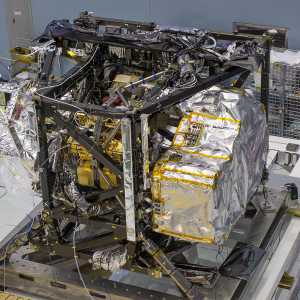
The Webb telescope’s four science instruments are housed together in a unit known as the Integrated Science Instrument Module (ISIM). Credit: NASA.
FGS/NIRISS
The Fine Guidance Sensor/ Near-InfraRed Imager and Slitless Spectrograph (FGS/NIRISS) is the Canadian instrument on board Webb. The FGS acts as the telescope’s eyes, allowing it to point at and focus on objects of interest. NIRISS can both take pictures and gather spectra, or light broken up into a distribution of its colours, in the near-infrared to study a multitude of different objects from exoplanets to distant galaxies. (Instrument Page)
NIRCam
The Near-InfraRed Camera (NIRCam) detects near-infrared light from some of the earliest stars and galaxies formed after the Big Bang, stars in nearby galaxies and our own Milky Way, and distant Solar System objects in a region called the Kuiper Belt. (Instrument Page)
NIRSpec
The Near-InfraRed Spectrograph (NIRSpec) collects spectra, like NIRISS, but for up to 100 objects at a time thanks to its innovative microshutter array technology. It will study the formation of stars and the chemical composition of very young, distant galaxies. (Instrument Page)
MIRI
The Mid-InfraRed Instrument (MIRI) studies mid-infrared light, slightly longer wavelengths than the other Webb instruments. This will help us better understand certain objects in our Solar System such as comets and the birth of stars. MIRI is also equipped with a coronagraph, a mask that blocks the glare of very bright objects to allow us to better see dimmer objects around it. (Instrument Page)
INFRARED LIGHT
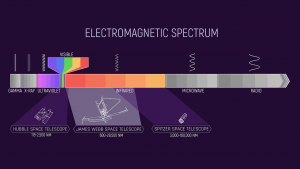
An illustration of the electromagnetic spectrum, specifically highlighting the portions detected by NASA’s Hubble and Spitzer space telescopes along with the Webb telescope. Credit: STScI.
There are many different kinds of light around us, beyond the rainbow of visible light we can see with our eyes. These types of light make up the electromagnetic spectrum and can be categorised by their wavelength. Very energetic light like x-rays have very short wavelengths, radio waves have very long wavelengths, and visible light is somewhere in between.
Studying different parts of the electromagnetic spectrum provides us with brand new information about the object we’re looking at. This is why astronomers make instruments that can study different types of light. The Webb telescope studies infrared light, which is beyond the red part of the visible spectrum.
Why study infrared light?
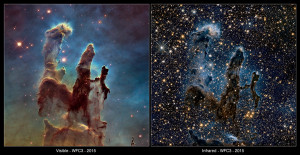
The Orion Nebula can be seen in visible (left) and infrared (right) light as observed by the Hubble Space Telescope. Observing infrared light allows scientists to pierce through the dust and study otherwise unseen parts of our Universe. Credit: NASA/ESA/Hubble Heritage Team (STScI/AURA).
- Certain objects in space like planets, giant red stars and a type of “failed” star called brown dwarfs are too cold to emit much visible light and are most visible in the infrared.
- Infrared light can pierce through dust grains that blocks visible light, revealing lots of hidden information.
- Light emitted by the very first galaxies ever created in the Universe is redshifted from ultraviolet and visible wavelengths to infrared wavelengths as it travels through an expanding Universe before reaching us and Webb.
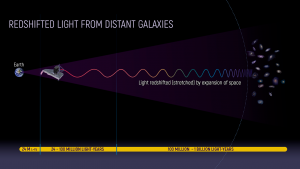
As light travels through our expanding universe, it is shifted towards longer wavelengths. This is called “redshift”. Credit: Space Telescope Science Institute.
HUBBLE’S SUCCESSOR
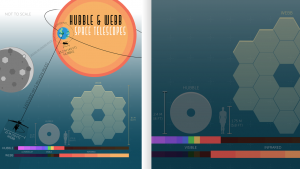
The Hubble and Webb space telescopes will be complementary observatories. The two spacecrafts differ in their size, shape, distance from Earth and observed range of light. Credit: NASA/Space Telescope Science Institute.
Arguably, no telescope has had a greater impact on our understanding of the Universe and the public’s perception of it than the Hubble Space Telescope launched in 1990. The Webb Telescope will build on Hubble’s impressive legacy of astronomy observations and even surpass it in many cases.
The Hubble Space Telescope allowed us to peer further into space than ever before, take breathtakingly detailed images of planets and galaxies, and answer many of the Universe’s great mysteries.
The Webb telescope will be Hubble’s successor, but not its replacement. The two missions have a planned overlap and will work together on new discoveries.
There are, however, many differences between these two space telescopes. Webb has unique capabilities that will allow it to perform science Hubble was not able to do.
| Hubble Space Telescope (HST) | James Webb Space Telescope (JWST) | |
|---|---|---|
| Observatory size | About the size of a school bus | About the size of a tennis court due to its large sunshield; will need to be folded up when it launches on an Ariane 5 rocket |
| Mirror size | A single 2.4m-wide mirror | 18 hexagonal mirror segments, for a total width of 6.5m |
| Mirror composition | Glass coated with aluminum | Beryllium coated with gold |
| Light observed | Ultraviolet, visible and near-infrared light, from 0.115 to 2.5 microns | Near- and mid-infrared light, from 0.6 to 28.5 microns |
| Location | In low-Earth orbit, at an altitude of 547 km | At the Lagrange point L2, orbiting the Sun 1.5 million km away from Earth. |
| Maintenance | Due to its location, Hubble can be repaired and upgraded while in orbit. Astronauts famously corrected Hubble’s mirror in 1993. | Due to its location, Webb will not be repairable over its lifetime. This highlights the importance of the rigorous testing Webb must go through before its launch. |
| Mission lifetime | Hubble was launched in 1990 and will remain operational as long as its instruments are functioning. | The minimum expected lifetime of Webb is 5 years but may go beyond 10 years. This will depend on how long its propellant, needed to keep Webb stable in its orbit, will last. |
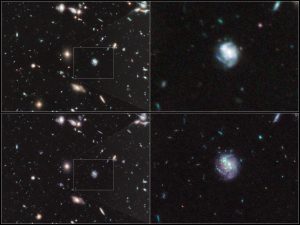
The top row shows Hubble’s famous Ultra Deep Field of distant galaxies with a zoom-in on a single galaxy. A simulated image of the same sky field as seen by Webb, bottom row, shows how much more detailed Webb’s images will be. Credit: Space Telescope Science Institute.
PARTNERS
The Webb telescope is an international collaboration between several space agencies:
- NASA (lead partner): overall responsibility for the Webb mission and the NIRCam and MIRI instruments
- Canadian Space Agency: the FGS/NIRISS instrument
- European Space Agency: the NIRSpec instrument, the MIRI instrument’s optics assembly and the Ariane 5 launch vehicle
a research institute:
- STScI: house Mission Control during the mission lifetime and provide science support
along with a number of industrial partners:
- Honeywell Aerospace (formerly COMDEV)
- Northrop Grumman
- Ball Aerospace
